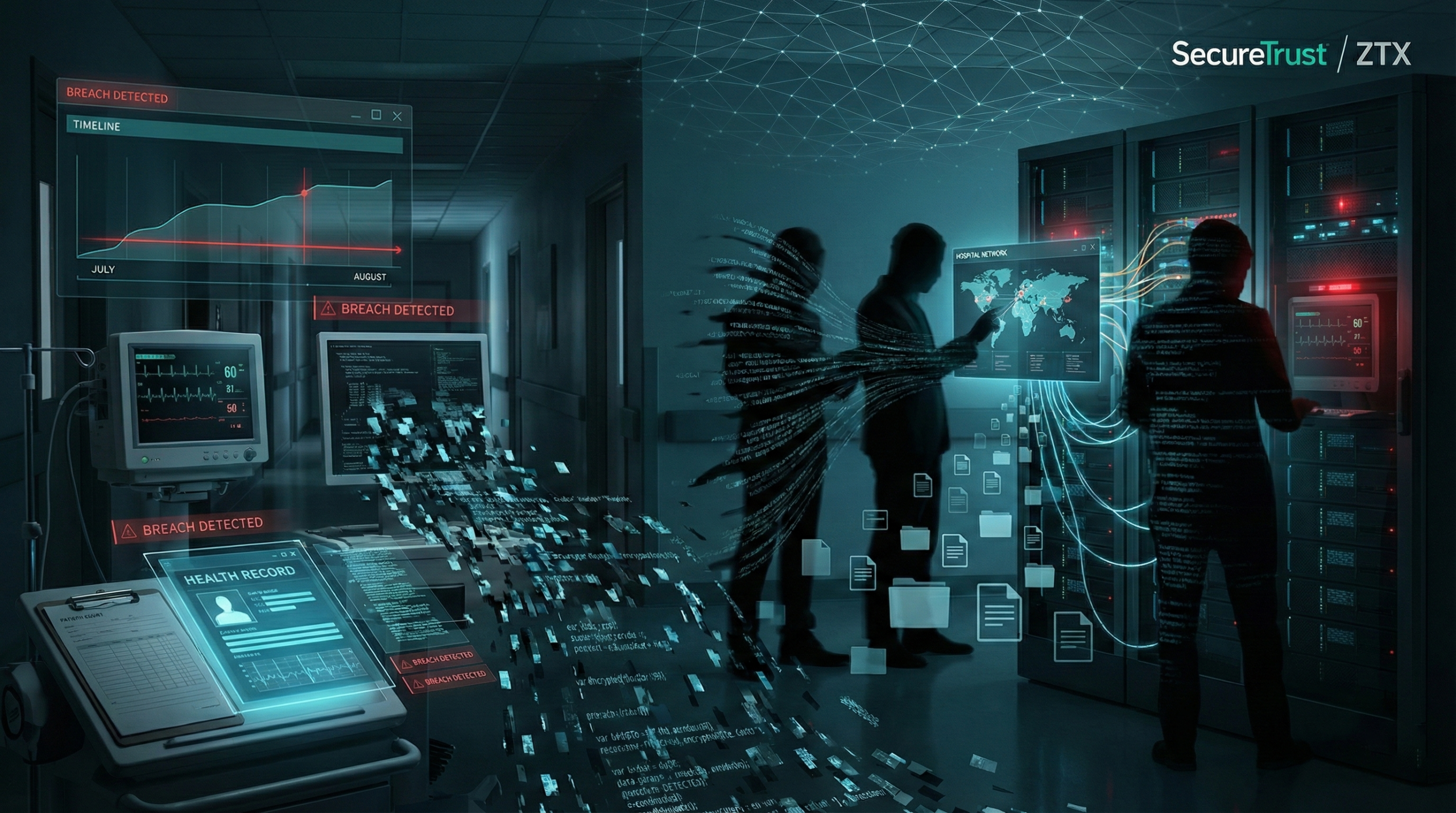Healthcare Cyber Risk: A CISO’s Comprehensive Roadmap for 2025-26
The healthcare sector is at a critical juncture. As telehealth, IoMT devices, and cloud-based EHR systems reshape patient care, they also expand the attack surface. Threat actors recognize the value of patient data—and the potential to disrupt life-saving operations. Meanwhile, CISOs face tightening budgets, compliance pressure, and a worsening skills shortage.
This 2025 roadmap helps healthcare CISOs align cyber strategy with clinical and business priorities, offering a blueprint that integrates governance, architecture, and human factors into a single cohesive risk-management program.
1. The Healthcare Cyber Threat Landscape
Healthcare remains the most targeted industry for ransomware. The IBM 2024 Cost of a Data Breach Report places the average breach cost at $10.1 million—nearly double other sectors. According to the U.S. HHS OCR, over 50 million patient records were exposed in 2024 alone.
Secure your business and remote users
Deploy the SecureTrust stack, reduce lateral movement, and monitor every endpoint, fully managed for you.
Book a Meeting NowWhy healthcare?
- High data value: PHI and medical histories fetch up to $1,000 per record on the dark web.
- Complex ecosystems: Cloud vendors, IoMT devices, and third-party software expand exposure.
- Legacy systems: Critical clinical assets often run outdated OS versions with unpatched vulnerabilities.
- Limited downtime tolerance: Attacks can halt patient care and jeopardize lives.
2. Embedding Cyber Risk into Enterprise Governance
Cybersecurity must evolve from compliance task to enterprise-wide risk discipline. A mature CISO program quantifies cyber risk in financial and clinical terms.
Key Governance Actions
- Integrate cyber risk into enterprise risk management (ERM) dashboards.
- Translate vulnerabilities into operational impacts—“What does 24 hours of EHR downtime cost?”
- Implement board-level metrics (MTTD, MTTR, vendor exposure, patch cadence).
- Run quarterly executive briefings aligning cybersecurity outcomes to patient safety KPIs.
| Metric | Target | Why It Matters |
|---|---|---|
| Mean Time to Detect (MTTD) | < 60 minutes | Stops ransomware propagation early. |
| Mean Time to Respond (MTTR) | < 4 hours | Reduces clinical downtime. |
| Third-Party Coverage | > 90 % | Most breaches start with vendors. |
| Segmented Medical Devices | ≥ 80 % | Limits lateral movement. |
3. Regulatory & Compliance Obligations
Healthcare CISOs must juggle multiple overlapping frameworks:
- HIPAA / HITECH – Safeguards for PHI and mandatory breach reporting.
- 21st Century Cures Act – Data interoperability and integrity requirements.
- CMS Cybersecurity Readiness – Participation condition for Medicare/Medicaid.
- Cyber-Insurance Underwriting – Now mandates MFA, EDR, and segmentation proof.
Compliance alone is insufficient. Treat these as minimums—resilience goes beyond checkboxes.
4. Core Risk Domains in Healthcare Security
4.1 IoMT and Medical Device Risk
Over 70 % of hospitals operate IoMT devices running unsupported software. Attackers exploit these unmanaged assets as gateways into clinical networks. Segment and monitor every device, enforce NAC (Network Access Control), and maintain an asset inventory tied to patch status.
4.2 Telehealth and Cloud EHR
Remote care introduces risk through insecure VPNs and misconfigured APIs. Enforce identity-based access, endpoint validation, and encrypted video/data channels for telehealth platforms. Review Business Associate Agreements (BAAs) with all cloud vendors annually.
4.3 Supply Chain and Third-Party Risk
Nearly 45 % of breaches originate from vendor compromise. The HSE Ireland ransomware attack showed how supplier intrusion can paralyze healthcare nationwide. CISOs must maintain vendor inventories, mandate annual audits, and integrate vendors into incident-response plans.
4.4 Ransomware Resilience
Ransomware remains the top threat. Health-sector victims experience an average of 7 days downtime. Immutable backups, microsegmentation, and tested restoration drills are critical to maintain patient services during disruption.
5. Operational Controls and Playbooks
Zero Trust Identity Architecture
- Implement passwordless MFA and conditional access policies.
- Continuously verify device posture and clinician identity before granting access.
- Apply least-privilege principles with automated entitlement reviews.
Network Segmentation and Microsegmentation
Separate clinical systems from administrative IT. Create isolated VLANs for medical devices and limit east-west traffic. Hospitals adopting microsegmentation reduced lateral-movement incidents by 50 % in independent assessments.
Vulnerability and Patch Management
Adopt risk-based patching. For unpatchable legacy devices, implement virtual patching and intrusion-prevention at the network layer. Maintain compensating controls and document exceptions for auditors and insurers.
Incident Response & Patient Continuity
Extend IR plans beyond IT restoration. Define clinical fallback procedures (paper charting, local imaging access). Conduct annual joint tabletop exercises with clinical leadership, IT, and communications teams.
6. Cyber-Insurance and Risk Transfer
Healthcare premiums rose 30 % in 2024 due to escalating losses. Insurers now demand evidence of EDR coverage, MFA, offline backups, and rapid-response playbooks. Maintain detailed architecture diagrams, control inventories, and third-party attestations to expedite underwriting and ensure claims eligibility.
7. Measuring Performance and Improvement
Adopt maturity models such as HITRUST CSF or NIST CSF. Track progress quarterly using both technical and business metrics:
- MTTD / MTTR trend over 12 months
- Vendor remediation cycle time
- Percentage of automated response playbooks executed
- Patient-care impact hours avoided (per incident)
8. Future Risks and Emerging Technologies
- AI-Driven Threats: Deep-fake voice and AI-authored phishing target clinicians.
- Quantum-Safe Encryption: Plan migration paths for PHI retention > 10 years.
- 5G and Edge Care: Expanded bandwidth = expanded attack surface; apply identity governance and zero trust edge gateways.
9. Action Plan for Healthcare CISOs
- Build a board-level cyber-risk dashboard with quantified exposure.
- Map and rationalize all security tools and third-party vendors.
- Segment critical networks and IoMT assets immediately.
- Automate incident response workflows for common threat scenarios.
- Integrate cyber-insurance and regulatory reporting into one resilience framework.
10. External References
- U.S. HHS OCR Breach Notification Portal
- Health-ISAC IoMT Security Guidance
- IBM Cost of a Data Breach 2024 Report
- World Economic Forum Cybersecurity Outlook 2024
Conclusion
Healthcare cybersecurity is no longer a purely technical discipline—it is a clinical imperative. CISOs who integrate cyber risk into governance, build Zero Trust architectures, and prioritize resilience will not only meet compliance mandates but protect lives.


